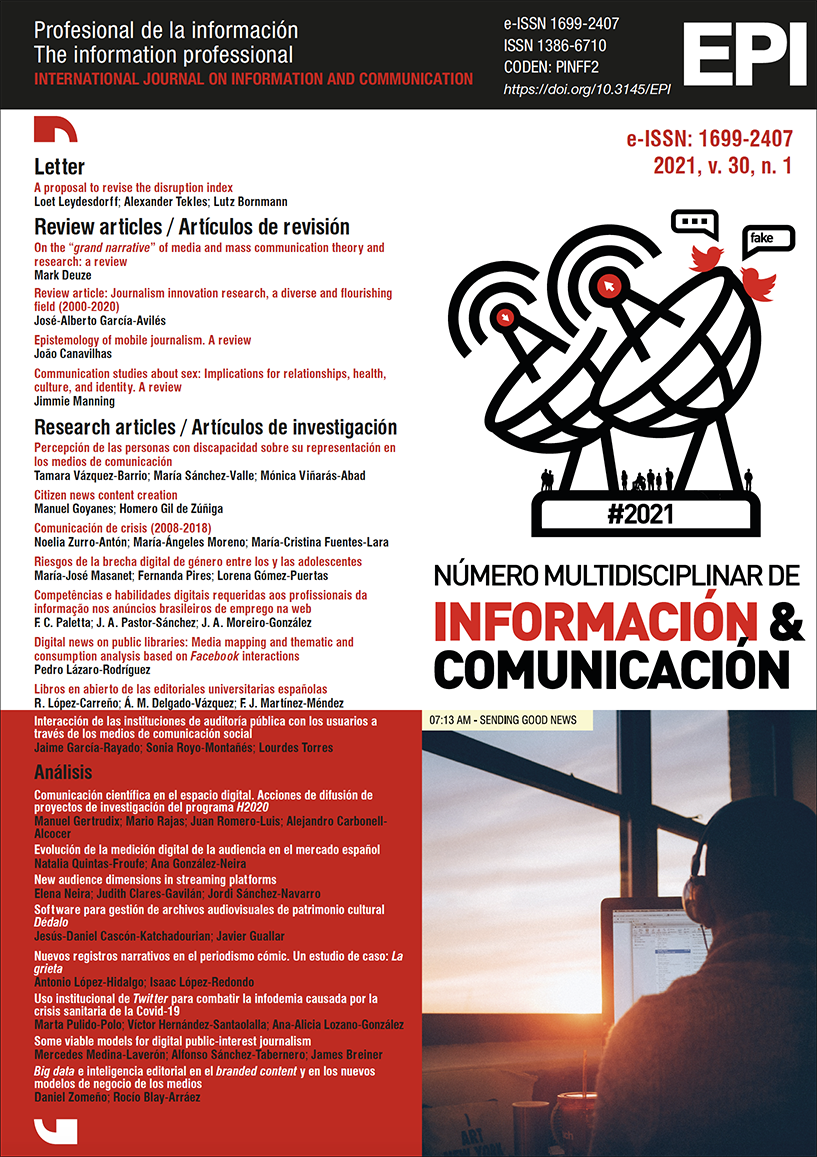A proposal to revise the disruption indicator
DOI:
https://doi.org/10.3145/epi.2021.ene.21Keywords:
Disruption, Consolidation, Indicator, Revision, Bibliographic couplingAbstract
The disruption index (DI) based on bibliographic coupling and uncoupling between a document and its references was first proposed by Funk & Owen-Smith (2017) for citation relations among patents and then adapted for scholarly papers by Wu et al. (2019). However, Wu & Wu (2019) argued that this indicator would be inconsistent. We propose revised disruption indices (DI* and DI#) which make the indicator theoretically more robust and consistent. Along similar lines, Chen et al. (2020) developed the indicator into two dimensions: disruption and consolidation. We elaborate the improvements in simulations and empirically. The relations between disruption, consolidation, and bibliographic coupling are further specified. Bibliographic coupling of a focal paper with its cited references generates historical continuity. A two-dimensional framework is used to conceptualize dis-continuity not as a residual, but a dimension which can further be specified.
Downloads
References
Bornmann, Lutz; Devarakonda, Sitaram; Tekles, Alexander; Chacko, George (2020). "Disruptive papers published in Scientometrics: meaningful results by using an improved variant of the disruption index originally proposed by Wu, Wang, and Evans (2019)". Scientometrics, v. 123, pp. 1149-1155. https://doi.org/10.1007/s11192-020-03406-8
Bornmann, Lutz; Tekles, Alexander (2019). "Disruptive papers published in Scientometrics". Scientometrics, v. 120, pp. 331-336. https://doi.org/10.1007/s11192-019-03113-z
Bornmann, Lutz; Tekles, Alexander (2020). "Convergent validity of several indicators measuring disruptiveness with milestone assignments to physics papers by experts", arXiv:2006.10606. https://arxiv.org/abs/2006.10606
Bu, Yi; Waltman, Ludo; Huang, Yong (in press). "A multidimensional framework for characterizing the citation impact of scientific publications". Quantitative science studies. https://www.mitpressjournals.org/doi/abs/10.1162/qss_a_00109
Chen, Jiyao; Shao, Diana; Fan, Shaokun (2020). "Destabilization and consolidation: Conceptualizing, measuring, and validating the dual characteristics of technology". Research policy, v. 50, n. 1, art. 104115. https://doi.org/10.1016/j.respol.2020.104115
Funk, Russell J.; Owen-Smith, Jason (2017). "A dynamic network measure of technological change". Management science, v. 63, n. 3, pp. 791-817. https://doi.org/10.1287/mnsc.2015.2366
Garfield, Eugene; Pudovkin, Alexander I.; Istomin, Vladimir S. (2003). "Why do we need algorithmic historiography?". Journal of the American Society for Information Science and Technology, v. 54, n. 5, pp. 400-412. https://doi.org/10.1002/asi.10226
Glí¤nzel, Wolfgang; Schlemmer, Balázs; Thijs, Bart (2003). "Better late than never? On the chance to become highly cited only beyond the standard bibliometric time horizon". Scientometrics, v. 58, n. 3, pp. 571-586. https://doi.org/10.1023/B:SCIE.0000006881.30700.ea
Heinze, Thomas; Shapira, Philip; Senker, Jacqueline; Kuhlmann, Stefan (2007). "Identifying creative research accomplishments: Methodology and results for nanotechnology and human genetics". Scientometrics, v. 70, n. 1, pp. 125-152. https://doi.org/10.1007/s11192-007-0108-6
Kessler, Myer-Mike (1963). "Bibliographic coupling between scientific papers". American documentation, v. 14, n. 1, pp. 10-25. https://doi.org/10.1002/asi.5090140103
Leydesdorff, Loet (1991). "The static and dynamic analysis of network data using information theory". Social networks, v. 13, n. 4, pp. 301-345. https://doi.org/10.1016/0378-8733(91)90001-A
Leydesdorff, Loet; Wagner, Caroline S.; Bornmann, Lutz (2018). "Discontinuities in citation relations among journals: Self-organized criticality as a model of scientific revolutions and change". Scientometrics, v. 116, n. 1, pp. 623-644. https://doi.org/10.1007/s11192-018-2734-6
Tahamtan, Iman; Bornmann, Lutz (2018). "Creativity in science and the link to cited references: Is the creative potential of papers reflected in their cited references?". Journal of informetrics, v. 12, n. 3, pp. 906-930. https://doi.org/10.1016/j.joi.2018.07.005
Van Eck, Nees-Jan; Waltman, Ludo (2014). "CitNetExplorer: A new software tool for analyzing and visualizing citation networks". Journal of informetrics, v. 8, n. 4, pp. 802-823. https://doi.org/10.1016/j.joi.2014.07.006
Wu, Lingfei; Wang, Dashun; Evans, James A. (2019). "Large teams develop and small teams disrupt science and technology". Nature, v. 566, n. 7744, pp. 378-382. https://doi.org/10.1038/s41586-019-0941-9
Wu, Shijie; Wu, Qiang (2019). "A confusing definition of disruption". SocArxiv Papers. https://osf.io/preprints/socarxiv/d3wpk
Downloads
Published
How to Cite
Issue
Section
License
Dissemination conditions of the articles once they are published
Authors can freely disseminate their articles on websites, social networks and repositories
However, the following conditions must be respected:
- Only the editorial version should be made public. Please do not publish preprints, postprints or proofs.
- Along with this copy, a specific mention of the publication in which the text has appeared must be included, also adding a clickable link to the URL: http://www.profesionaldelainformacion.com
- Only the final editorial version should be made public. Please do not publish preprints, postprints or proofs.
- Along with that copy, a specific mention of the publication in which the text has appeared must be included, also adding a clickable link to the URL: http://revista.profesionaldelainformacion.com
Profesional de la información journal offers the articles in open access with a Creative Commons BY license.




